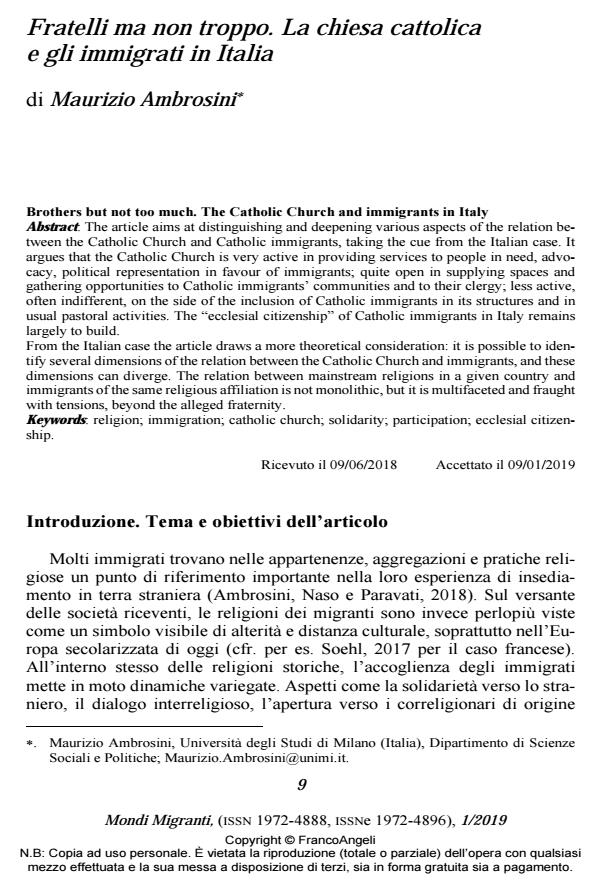Brothers but not too much. The Catholic Church and immigrants in Italy
Journal title MONDI MIGRANTI
Author/s Maurizio Ambrosini
Publishing Year 2019 Issue 2019/1
Language Italian Pages 19 P. 9-27 File size 200 KB
DOI 10.3280/MM2019-001001
DOI is like a bar code for intellectual property: to have more infomation
click here
Below, you can see the article first page
If you want to buy this article in PDF format, you can do it, following the instructions to buy download credits

FrancoAngeli is member of Publishers International Linking Association, Inc (PILA), a not-for-profit association which run the CrossRef service enabling links to and from online scholarly content.
The article aims at distinguishing and deepening various aspects of the relation between the Catholic Church and Catholic immigrants, taking the cue from the Italian case. It argues that the Catholic Church is very active in providing services to people in need, advocacy, political representation in favour of immigrants; quite open in supplying spaces and gathering opportunities to Catholic immigrants’ communities and to their clergy; less active, often indifferent, on the side of the inclusion of Catholic immigrants in its structures and in usual pastoral activities. The "ecclesial citizenship" of Catholic immigrants in Italy remains largely to build. From the Italian case the article draws a more theoretical consideration: it is possible to identify several dimensions of the relation between the Catholic Church and immigrants, and these dimensions can diverge. The relation between mainstream religions in a given country and immigrants of the same religious affiliation is not monolithic, but it is multifaceted and fraught with tensions, beyond the alleged fraternity.
Keywords: Religion; immigration; catholic church; solidarity; participation; ecclesial citizenship.
- Immigrant Religious Networks in Milan: Ethnic Churches as Source of Social Capital Samuele Davide Molli, in MONDI MIGRANTI 1/2020 pp.97
DOI: 10.3280/MM2020-001006 - Problematising use conformity in spatial regulation: Religious diversity and mosques out of place in Northeast Italy Daniela Morpurgo, in Planning Theory /2023 pp.201
DOI: 10.1177/14730952221117756 - The Role of Civil Society Organisations in the Integration of Migrants, Refugees and Asylum Seekers in the Italian Labour Market Mattia Collini, in VOLUNTAS: International Journal of Voluntary and Nonprofit Organizations /2022 pp.897
DOI: 10.1007/s11266-022-00489-0 - Diversity and Inclusion in Italy Alberta Giorgi, pp.117 (ISBN:978-3-031-81937-7)
- “The Good Must Be Done Well”: Sheltering Illegalised Migrants at Church in a Context of Policing Humanitarianism Daniela Trucco, in Journal of International Migration and Integration /2025
DOI: 10.1007/s12134-025-01271-z - Introduzione. Fedi in movimento. Luoghi, aggregazioni e identità religiose in emigrazione. Maurizio Ambrosini, Roberta Ricucci, in MONDI MIGRANTI 1/2020 pp.19
DOI: 10.3280/MM2020-001002 - Catholic Parishes and Immigrants in Italy: Insights from the Congregations Study in Three Italian Cities Marco Guglielmi, Olga Breskaya, Stefano Sbalchiero, in Societies /2024 pp.77
DOI: 10.3390/soc14060077 - Immigrant Christianities Monica Chilese, pp.59 (ISBN:978-3-031-89090-1)
- L'impatto dell'immigrazione sulle congregazioni cristiane: la pluralizzazione del Cristianesimo nella regione Veneto Marco Guglielmi, in MONDI MIGRANTI 1/2020 pp.75
DOI: 10.3280/MM2020-001005 - The multifaceted relationship between individual religiosity and attitudes toward immigration in contemporary Italy Riccardo Ladini, Ferruccio Biolcati, Francesco Molteni, Andrea Pedrazzani, Cristiano Vezzoni, in International Journal of Sociology /2021 pp.390
DOI: 10.1080/00207659.2021.1937778 - Religion Between Governance and Freedoms Marco Guglielmi, Stefano Sbalchiero, pp.223 (ISBN:978-3-031-69879-8)
- Immigrant Women’s Protagonism: Exercising Leadership Roles in Ethnic Churches at the Time of the Pandemic in Italy Samuele Davide Molli, in Religions /2022 pp.696
DOI: 10.3390/rel13080696 - Perceptions of Lampedusa as an Immigration Hub: Four Populations in One Small Island Place? Marco Casagrande, in Folk, Knowledge, Place /2024
DOI: 10.24043/001c.125319
Maurizio Ambrosini, Fratelli ma non troppo. La chiesa cattolica e gli immigrati in Italia in "MONDI MIGRANTI" 1/2019, pp 9-27, DOI: 10.3280/MM2019-001001